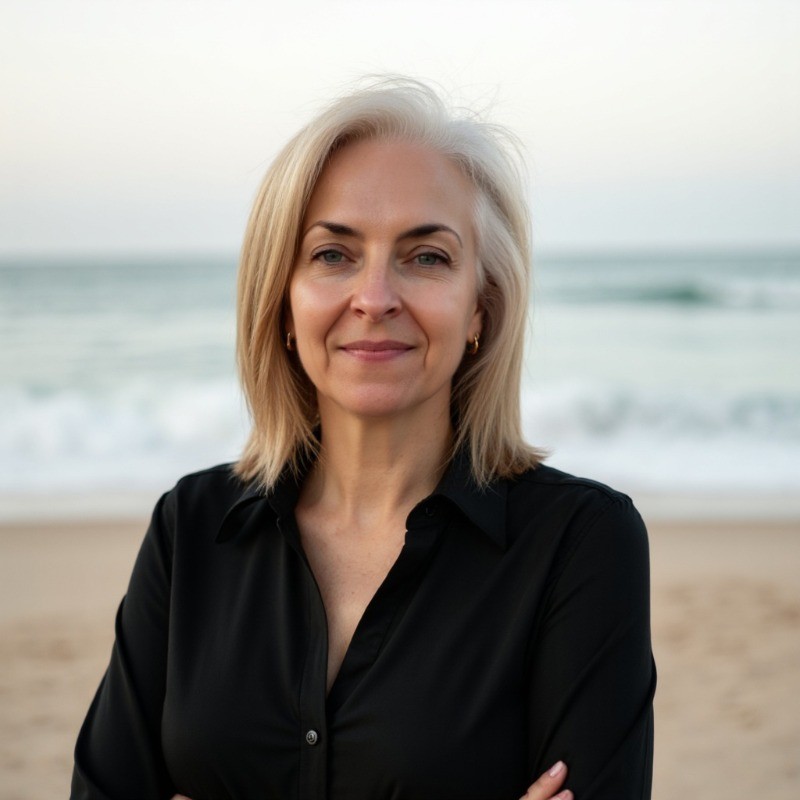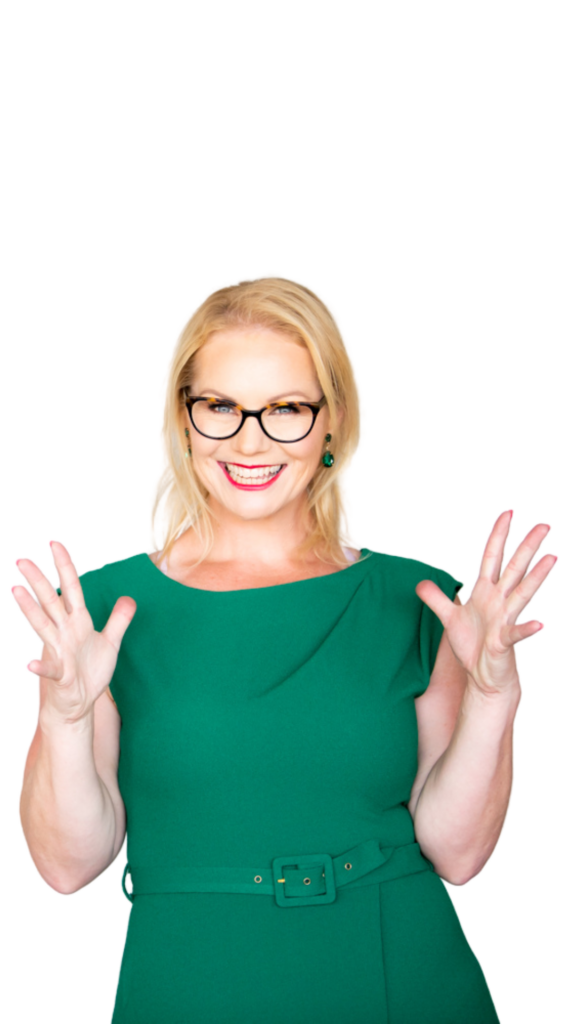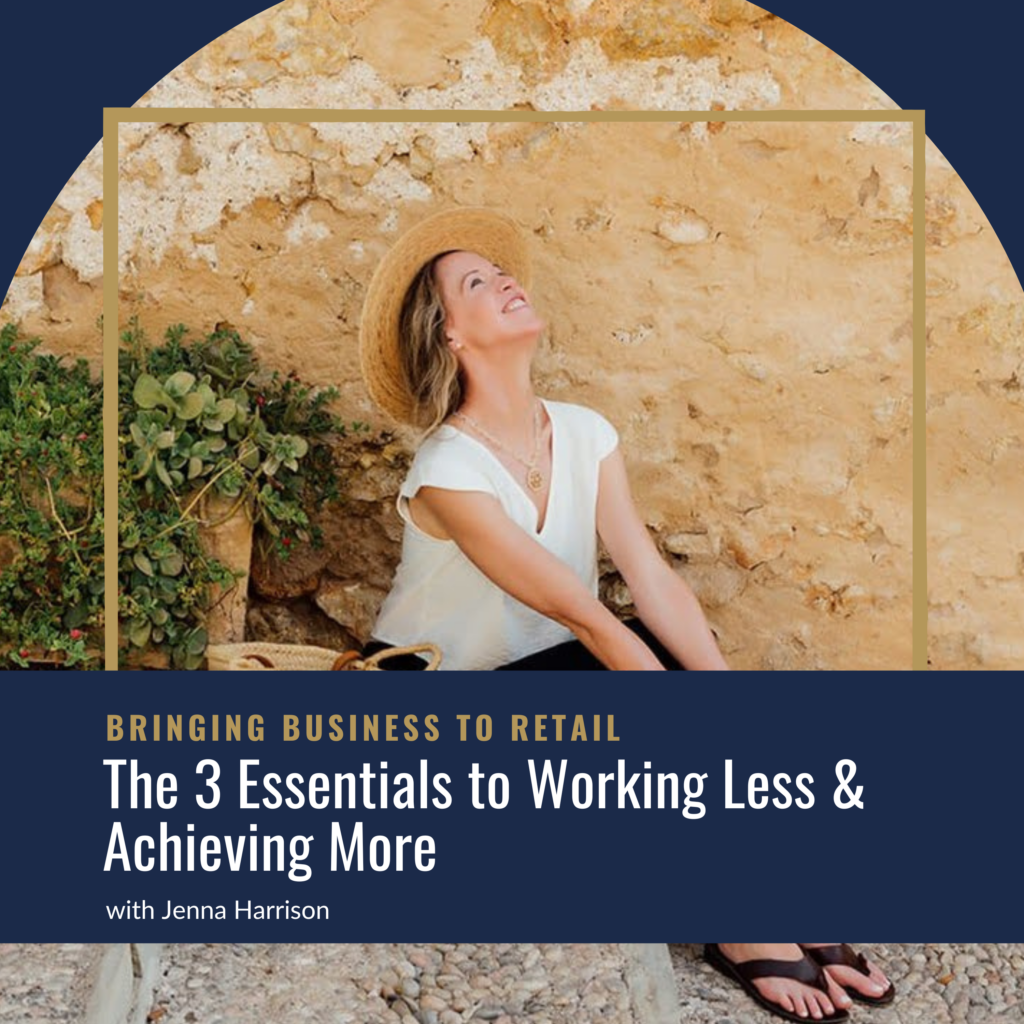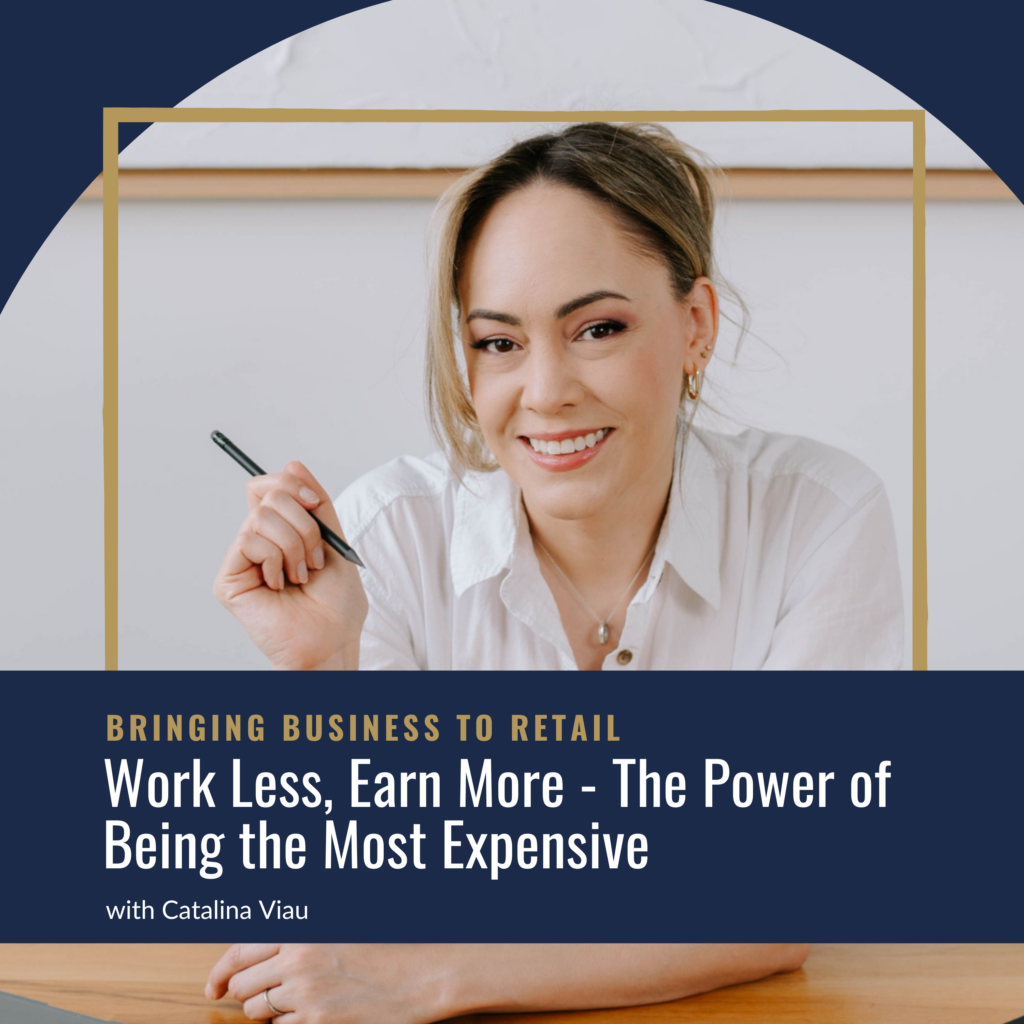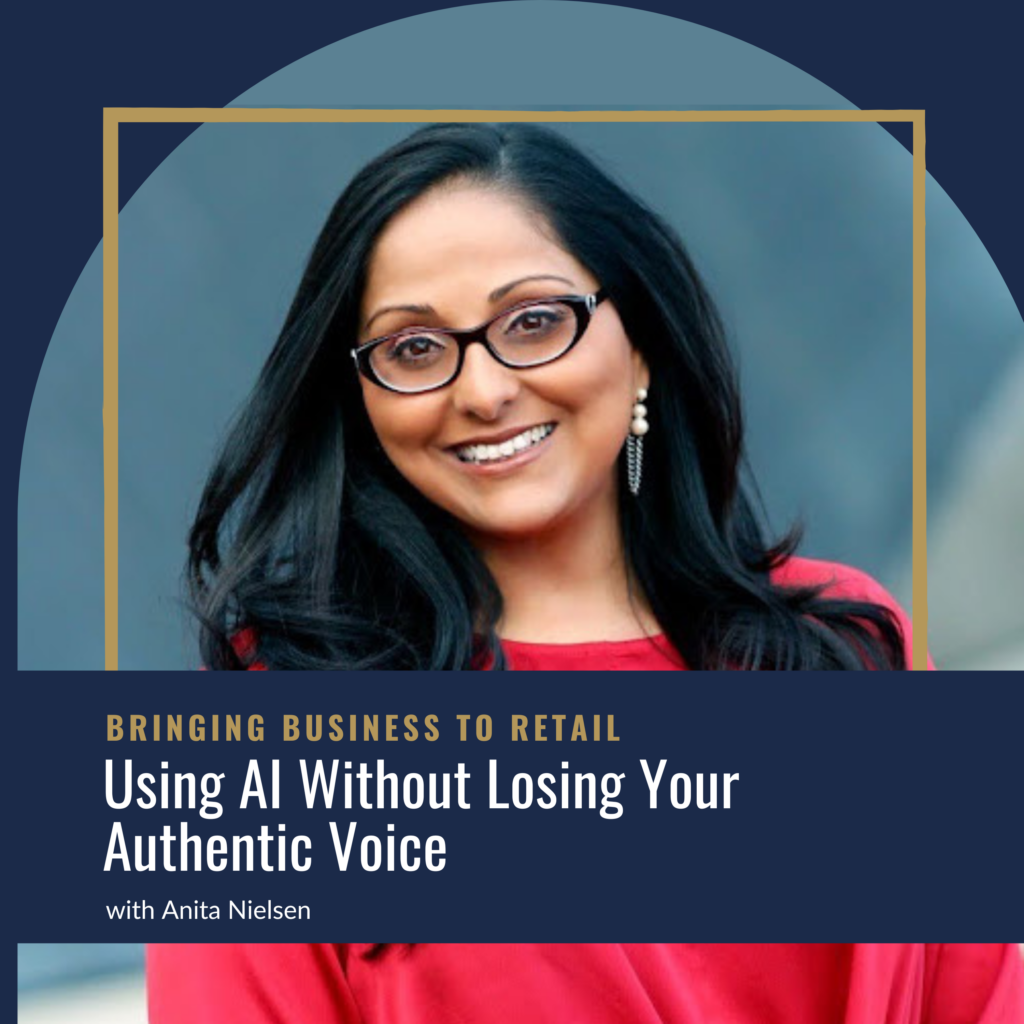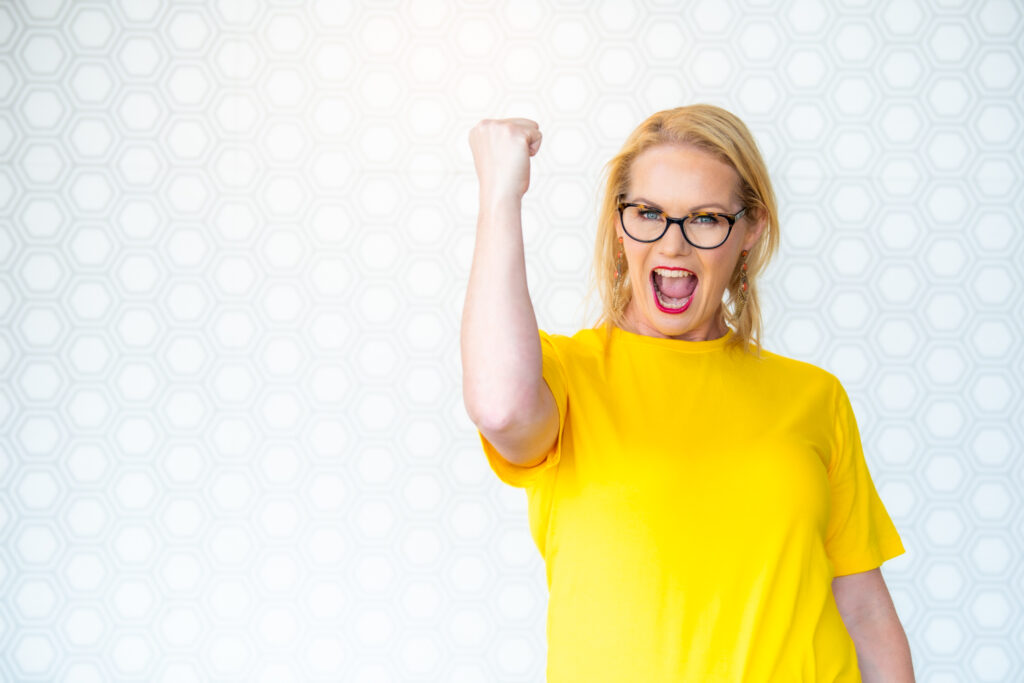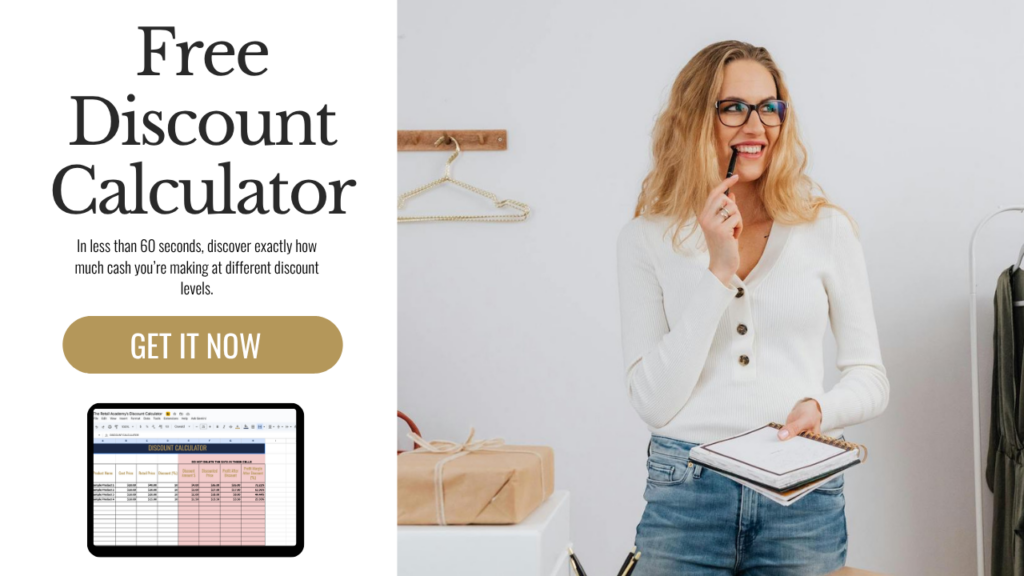
SHOW NOTES
I’m so excited to share this conversation with Lisa Sjöblom, founder of Tyoub Swimwear. Lisa’s story absolutely blew me away – she turned her frustration with disposable swim nappies into a thriving sustainable children’s brand by making bold investments when others played it safe.
What I loved most about our chat was how Lisa consistently chose to invest in her business growth – spending $3K on trade shows when others spent $150, jumping onto marketplaces despite commission fees, and always showing up even when it felt uncomfortable. Her willingness to take calculated risks has paid off in a big way.
In this episode, Lisa shares:
- How she scaled from making $800 at a local market to selling internationally
- Why she pivoted from local markets to major trade shows (and the mindset shift required)
- Her strategy for using post-consumer recycled plastics in premium swimwear
- How she built her brand by leveraging other businesses’ platforms
- The art of “showing up” at industry events and building genuine relationships
- Why marketplace commissions beat wholesale margins
- Her biggest lesson after 8 years: invest in people, not just systems
My biggest takeaway: Success often comes from being willing to invest when others won’t. Lisa’s story proves that playing it safe isn’t always the safest option.
TIMESTAMPS
[00:00] My sustainability journey and introducing Lisa
[01:00] How Tyoub was born from textile expertise and eco-consciousness
[04:00] The market moment that changed everything
[06:00] Strategic pivot to major trade shows
[08:00] Taking the $3K leap when others stay at $150
[11:00] Staying ahead with sustainable innovations
[13:00] Keeping up with industry changes
[15:00] The marketplace strategy – growing on other businesses’ coattails
[18:00] The art of showing up and networking effectively
[21:00] Building relationships as an immigrant entrepreneur
[23:00] Staying focused while exploring opportunities
[25:00] Why marketplaces work better than wholesale
[30:00] Understanding customer acquisition costs
[32:00] 8 years of lessons learned
[35:00] Final thoughts on investing in people
CONNECT WITH LISA
🌊 Website: https://tyoub.com.au (that’s T-Y-O-U-B) 💼 LinkedIn: https://www.linkedin.com/in/lisa-sj%C3%B6blom-84365b60/
I’d love to hear what resonated with you from this episode! Connect with me on socials @thesalenanight and let me know your biggest takeaway.
Sal
LISTEN NOW on The Bringing Business To Retail Podcast
Episode 481
===
[00:00:00] Sustainability has always been close to my heart. I remember when I was only about five years old that we were doing a cleanup at home and there was this massive stack of newspapers, which just goes to show you how old I am. And I distinctly remember. I feel like this was my first eco moment. I distinctly remember saying to my parents at the time.
Are we just gonna throw these in the bin? Like can't we do something with them? And I remember them looking at me like I had foreheads, like it's rubbish. Throw it in the bin. Now, in my previous life I was a horticulturist. I was an arborist. And I went on to found sustainable chil baby and children's store long before eco and sustainable were buzzwords.
I used to joke that I was like 10 years ahead of the crowd. And it's interesting now to see. The products that I used to sell and have now, which were, you know, crunchy hippie mama products are now, you know, so mainstream. And today's guest has built an amazing brand around recycling [00:01:00] sustainability and encouraging us to get out and about with our kids.
She has been extremely strategic about the tactics that she's used to scale. Lisa, she founder of Tyoub. Welcome to the Bringing Business to Retail Show where we talk all about strategies to grow yourself, your business, and of course your bank account. Hi, Selena. Lovely to be here. I'm so happy that I've been biased on your show.
We can chat about sustainability and. Yeah. All the things that we are passionate about. Um, so happy to be here. Alrighty. Tell us how Tube was born, because I feel like I may have been there almost at the beginning. I remember you turning up to scale your store calls at your sewing desk and you would be sewing while we were doing our q and a sessions.
Yes, absolutely. So I have a background in textiles and in fashion design. So construction and kind of. Textile professional, [00:02:00] if you like. And so I've always been passionate about fabrics where they come from. Super curious and pretty much a life learner when it comes to the fashion industry. So yes, I discovered your podcast, oh gosh, it must have been back in 20, maybe late 20 15, 20 16.
And I started, my kids were still at school. I was working in the fashion industry at that time as a Garmin tech and just listening to your podcast, always really excited about starting my own brand. And then at the same time, I was sewing for my own children. I started making the swim nappies after seeing how many were in the bins after swimming lessons and just selling them at markets.
So yes, I was making them myself, but there was always that. This isn't complete. The fabrics weren't made from recycled plastics at that time. All I was able to get [00:03:00] hold of was those fossil fuel polyesters, but the fact that they were reusable was encouraging for me. Wow. That is like OG that at, I think I started this podcast in 2015.
So you've been there like right from the beginning. You've seen all of the iterations. So we've been on this journey together. Yes, we have been, which is really exciting. So you creating these products for your kids and having been in that reusable nappy industry, I, I'm, I'm all with you. That was the same for me.
For, for me, it was going into having a baby and thinking, can I literally just fill my bin up with poopy dappy every week? Because that's what people do and it just. It defied all logic in my brain, and that's how I ended up in reusable nappies, you know, bamboo, eco skincare, all that kind of stuff. So you were building the, you were creating these for your kids.
At what point, because you said it [00:04:00] was kind of an inkling in the background. At what point did you go, huh, I'm gonna make this an actual business that I can make money from. I would love to know what was the, what was the moment where you went, I'm gonna do this. Um, I think it was after my first market, which was here in Melbourne, um, just near the Brunswick Bar.
And we, it was Christmas market, so we started on the Friday night and on the Friday night we made, I don't know, about $800 and the following day we made a thousand dollars or more, literally add in an a OV of like $40. So we were selling our little rash fists and our swim nappies, and I came home and I said to my parents and my husband, this is amazing.
And from that point on, I think I discovered you and we started, I was going to make this business work on a larger scale. So I started [00:05:00] down the e-commerce part and I quickly became disillusioned with the cost of a advertising, the cost of that customer acquisition, the fact that the kids, you know, are in that.
At that point we were only going up to a size five. So I felt as though unless parents were buying, you know, for a second baby. And the swim nappies were of such great quality that people would come back to me after two years and say, we're still using them. And I was like, oh, that's great, but can you buy another one?
Yeah. I feel your pain because this is, I mean, I didn't know this when I first started out. Like I didn't, you know, I, I don't remember in my business degree anyone talking about things like customer lifetime value or. Knowing what that customer cycle looks like. And I remember the same thing. I only went up to the age of two, so I, I literally had from pregnancy to the, I had three years max that, you know, I had a customer for, but then if I was selling products that was so good that they didn't [00:06:00] need to buy them again.
Huh. That is maybe not the best business model to be running, as I discovered in hindsight. And I think what happened with me as well is that, that I was trying to get myself out there so much. I was doing all sorts of markets. Some markets were an absolute disaster because I'd be standing, you know, next to people selling candles and you know, all of that sort of thing.
And so I decided to. Be focused more on the bigger PBC expos, the one fine babies, and that really drew my demographic in and I started to realize this is where you need to focus. You need to be far more strategic in where you place your time, your energy, and your resources. Okay? Those people who don't know PBC is our pregnancy baby and Children's Expo and one fine baby.
Very similar. What you've kind of glossed over, and I want people to really appreciate as they're listening to you, is you've [00:07:00] gone from doing a local market, which might be, you know, 80, a hundred, $150 to have a stool to essentially an expo, which any of us who've ever done expos know that you are looking at usually around two or $3,000 for a booth minimum.
And then on top of that, you have your travel costs, you have your shipping costs, you have your printing costs. There are so many other logistics. That come into doing that level of, you know, show. And so what was the, because most people would get scared, most people would think, well, I, you know, I'm safe. I feel safe paying $150 because I don't have to make as much money.
If I have to spend $5,000 to be at a show, then my ROI has to be 10, 15, $20,000. And I just don't know if that's going to happen. How did you. Make that leap because something that you've been very, very good at is, I guess, zigging when other people zag or being able to take that leap where [00:08:00] other people would stay safe.
I think it was investing in inventory and knowing that I had a certain number of units that I had to strategically move. So planning out. Knowing when I had an expo, and that was the other thing, is that I really focused on the swim nappies and that became my, the core of my business. The one thing I'm trying to do now as we grow and scale is to introduce more product and just have a little bit more.
Diversification because the swim nappy, when I first started doing it, there were very few businesses that were selling swim nappies that were doing the cloth nappies, but not so much the swim nappies. So that really was my unique selling my UPS and so, or USP unique selling 0.0 UPS can deliver it for you.
That's fine. That's fine. Yes, my dyslexia [00:09:00] anyway. So that was when I started at the expos. I was the only person who was selling swim, and we also had the UV safe and you know, fashion swimwear for the children. So parents were really interested in getting their kids into early swimming lessons, and so we were able to kind of leverage on that unique difference that we had, especially at the shows.
And then we kind of pivoted from. Those shows into then being introduced to bigger players like Chemist Warehouse, and that was actually through one of those expos. So I think that showing up and being consistent year after year pays up when the bigger brands then see, you know, here's this little brand and she's been around now three or four or five years.
She's obviously got something of value. Yeah. Yeah. And, and if you hadn't have taken that leap, then you would never have realized. And I think we forget as we [00:10:00] go into these trade shows that it's not always just selling direct to consumer or even just selling direct to other retailers is there are buyers for large chains that are out there scoping products.
So, fast forward to now, you can buy a reusable swim net at Kmart, at Walmart, at Target, at all the places. How have you. Managed to stay ahead of the curve, because I think that is something that comes up quite often is you could have a product that is a best seller, you know, year in, year out, and then all of a sudden nobody wants it.
And not to say nobody wants your product, but the market shifts and the market changes. How have you managed to stay in front of the market? I think it's bringing it back to quality and to our core values. So as we started in the beginning talking about sustainability, the fact that the swim nappies are now made from post-consumer waste, that we have the global recycled standards, so that [00:11:00] GRS stamp of approval, all our fabrics are certified and independently tested.
Um, and I think that gives parents a real, uh, peace of mind around, you know, the formaldehyde, the migration of elements. And all our products are pH tested. So for children who have sensitivity to plastics, which I believe all children do, because plastics should not be in their bodies, especially with nasty chemicals, that has kind of set us apart and I think people are willing to pay for that peace of mind.
Um, so the design is such that it does grow with your child, so you don't need to be constantly guessing, which is the next size up. So it becomes a very handy and easy transaction, and people don't have to, especially if they're buying a gift, it's the first question, is it going to fit especially with children because they have such rapid growth.
So tell me more about the [00:12:00] post post consumer recycling. What were the words that you used there? So we use post-consumer plastics. So it's single use, often single use plastics that are discarded mostly into landfills. Some of it comes from ocean plastics. Our swimwear is made from ocean plastics and post-consumer waste, and that waste has then taken, it's processed and.
A lot of the fabrics that we are using, in fact, are created in a closed loop or closed uh, manufacturing environment. So they take account of their water and they recycle their chemicals so they're not just dumping waste directly back into the environment. Post manufacturing of their fabrics. That's really interesting because I think when sustainability is your core promise, when it is your [00:13:00] unique secret selling point, when the market changes and when technologies change, you need to stay updated.
How, how do you keep up to date with everything that's going on? I mean, you are running an amazing business. We haven't even gotten to the part where you sell internationally. I, I wanna get into that. But how are you keeping up with everything that's happening in the market, everything that happens, you know, in the industry, everything that happens with your textiles.
Yeah. I think that it's my curiosity that keeps me engaged. I find it absolutely fascinating. And when people are, you know, really down and, and out about the environment, I'm very positive because I see such innovation in this space. And we are constantly looking for improvements in our textiles and in our offerings.
To begin with, it was really expensive. Um, and hence the price of, you know, that sustainable and recycled is always gonna be a couple of dollars more [00:14:00] expensive. But honestly, as it becomes more mainstream, the prices do come down, which is great. And of course, it's so much better for, for the planners. Okay.
Pricing that inevitable struggle. It's the inevitable thing that people get hung up on. Tell me about how your pricing has evolved over the years. I think it's got, it's gotten much better. Obviously we've had to test, in the beginning it was our margins were, were much slimmer. But as I said earlier, because it's the fabrics are becoming more readily available, they don't come at that premium pricing.
Yes, we're still paying a little bit more, but nothing like we were paying in the past. So now we're able to be more competitive in our pricing, which has enabled us to then sell on these bigger platforms, which has been really great. Okay. Tell us about that, because. One of the reasons I [00:15:00] wanted to have you on the show is you have by your own admission grown this business on the back of other businesses coattails, and I love that you say that.
I would love you to talk us through that. Also, like I said at the beginning, you have not been scared to try different things, to get your brand out there, to push yourself out of the comfort zone when so many people, just like when you were prepared to spend thousands of dollars on those trade shows, when other people you know are prepared to spend 150.
You have taken these leaps of faith to get your brand out there, so I would love you to walk us through what that looks like. I wanna, I wanna hand it over to you because you are so passionate about the things that you've done and I would love to for you to walk us through that. Okay. Look, I think that, as I said, showing up has rarely been pivotal for me in gaining access to these bigger platforms.
I'm. Active in the retail community [00:16:00] here in Australia. So through the National Online Retailers Association and through trade shows, sourcing expos, I'm always connecting with people. So I think that that relationship building has been very important. And what it's led to is post an event, I'll get a message, an email saying, you know, lovely to.
Would you be interested in hopping on our platform? Let's have, you know, a kind of discovery call and let's see if this is gonna work. And then subsequently that ends up with the contracts in place and me plugging my little e-commerce Shopify store into the back end of these absolute giants, which is very exciting.
A bit nerve wracking. At the same time, but it's lovely to see, you know, the sales kind of uptick and to have that consistency and flow [00:17:00] with the conversions kind of coming through. And then being able to now start look looking to buy into retail media opportunities with them as well. So. It has been a little organic, but it's also been through effort.
Yes. You said showing up and you said going, going to conferences and trade shows, but what does showing up look like to you? Because you have done this really, really well and I would, I wanna dig into the nitty gritty here because so many people would think, oh, I'm not going to go to that Nora event, or I'm not gonna go to the NRF show because it costs $700 to go.
Or I'm not gonna go to the trade show because I'm not buying anything. Like I'm, I'm, I'm a reseller, so I won't go to the trade show. What, how do you show up in a way that works for you? I think it's. Being authentic and being honestly really interested in one, growing my business, and then two, [00:18:00] offering these beautiful, delightful products to the consumer.
So I think just having that belief in my product, and when I go to these events, I always look. Who's going to be presenting, you know, what opportunities are there in the room. And just putting myself in sometimes slightly uncomfortable positions, just standing by and then introducing myself with the hello, what brings you here today?
Or when I know exactly what brought them, you know, the today and who they are. And then making sure that they know who I am by the end of the event. So it's definitely been. Journey and I thought I was an introvert. Perhaps I'm not. I don't know. I kind of play with that because it does make me incredibly nervous, but I think it's exciting as well.
Interesting. And what I love about you is that even though there has been an event that is an investment, 700, a thousand, $1,500. [00:19:00] Time and time again, you have been prepared to play, prepared to pay, to play. We'll get all those words out, all those P words out. When you make a decision like that, do you go in with, I need to get a return on this investment, or is it just your naturally curious nature?
Like so many people find that they, you know, they will not go to an event because it is $700 a thousand dollars and they just think, I can't afford to spend that. They think of it as an expense, but when you are talking. You are thinking about it as an investment? I do. It's a life experience. You know, it's an opportunity to be amongst brains in the room, like at this incredible brain trust.
And look, there have been events that I've been to, uh, rad Trader events where you've got CEOs and founders of these incredible brands, Australian, like iconic brands, and. Just being there has been a nut for me. I haven't, you know, come away with a business [00:20:00] contact or anything, but it's just been, it's just been an experience and I love that.
I think it's really important to live your life as fully as possible. You know, it, it does cost, but honestly it's the, the payback is rewarding in both sales, uh, connections, but experience as well. Do you feel if I, like, if you wouldn't have made those investments, you wouldn't be where you are today? Yes, I do.
I think it's been, it's been absolutely imperative that I am connect with people and, you know, just growing, having immigrated to Australia from Sweden. And prior to that, having lived in the uk, I've always been the small fish in the big punt. And I've always come in not knowing anyone. So I've really had to meet peoples, you know, not having a foundation here has encouraged me to and forced me really to get out there and [00:21:00] meet people when we were at an event recently.
It was interesting to hear how many people knew you and how warmly they spoke of you. So you are clearly doing the connecting thing well, and you are putting yourself out there. So congratulations because you say that you're an introvert, but even if you are an introvert, you are being able to adapt to the situation because you clearly want this to work.
I mean, it's been, what is it been seven, eight years now since you first started? Are you? I look at you. And think you have come so far. You are amazing. How do you feel eight years later? Oh, I, I still feel like there's so much more to do. You know, when I look at Miracle Connect, for example, which is, I. This marketplace ecosystem, and I see the possibility.
It just, I get so excited because there's opportunities to go internationally to Nordstrom's and Macy's and [00:22:00] Sachs and, and who knows where from there. So I just get more at, the more I search and discover, the more I want to, to put myself out there. Grow much to my accounts and horror. And how do you choose which path to take though, with so many paths that you could go down?
How do you stay focused? I think it's through curation and knowing where my customer is, who I'm going to align with. I think that that has been really important, is knowing my customer. I think the, you know, the customer is king. It's key to your business. And without knowing what they're looking for and giving them, you know, the products that they need at that particular time and point is really important.
So yeah, I think that customer is the most important. So where my customers are, I will hopefully find them through these bigger marketplaces. And I [00:23:00] think when I hopped onto the baby bunting. Marketplace. That was also, it really showed me how seasonal my product was and exposed the weaknesses in my business.
And this year we've brought on the, the bamboo sleepwear just to tide us over the, the cooler winter months. And of course, I'm really hoping to build the range out into more, you know, winter, winter heavy things, travel resort. Yeah, so you have to watch this space. Lina, the marketplaces, I hear people over and over again shunning marketplaces because they have to pay a commission when they sell products.
What made you, I mean, I think it's, I think it's without saying that you are prepared to invest, I think, like, I didn't realize this is where the conversation was going to go before we hopped on, but the thing that you have repeatedly come up. Over and over again saying [00:24:00] is, I was prepared to invest. I was prepared to put my hand in my pocket and get myself in the room to get myself on into the trade show to do all of these things.
But tell me about marketplaces. When did you jump on them? Because it's not something we talk about a lot. When did you jump on the marketplaces and what did it do for your business other than. I mean, taking away nothing else, the fact that it highlighted a weakness in your business, that in and of itself was worth the effort.
But what has it done for your business by putting yourself onto these different channels? I think that it, it builds trust within the community. So I think that by align with bigger businesses, you've become associated, you know, by extension and also. The other thing is that it made me really have to do the legwork on finding and supporting my sustainable claims.
So with these marketplaces, it's not a case [00:25:00] of just putting up your product, they have to comply with the a ccc. So all your product safety standards have to be there. So that was one thing I really looked at really carefully. The other thing with the marketplaces is that it made me look at my numbers again.
And I realized that actually when I look at my e-commerce store, the greatest margin is obviously that direct sale, that vertical sale. And then the next best option for me is in fact the marketplaces, just with the reach that they have. And you know, there, as I said before, there are their own ecosystem with their own advertising and opportunities to hop on to their sales events.
And then of course, that there's that trust element, which is so important that people feel comfortable transacting with these businesses and knowing the product's gonna be delivered timelessly. And yeah. So I [00:26:00] think it's, all of those things are really important. I. It's interesting you should say the trust factor because a lot of people will assume that if I put my product on a marketplace, I'm diluting my brand.
But actually what you are saying is by having your product on baby Bunting, on Toys us, on Sacks, on Nordstrom, on all of these platforms, it actually improves your business trust and it improves your business brand. And not only that, you, you have your. Best margin is obviously going to be end, end consumer, and then a marketplace.
A marketplace is going to take what, anything from 10 to 30%? Is that kind of the commissions that you see? Yeah, it's more around the 17 to 25. I'm in negotiations with the marketplace at the moment who are just looking at recycled and sustainable products, and there a commission is around 35%, which I [00:27:00] think is really, really high.
So I'm going to. Obviously be negotiating that, but I think that around that 20% mark is really where you want to be sitting with the marketplaces. Whereas if you go wholesale, then you are looking at 50% that you are giving, losing, giving away whatever word you wanna use that is not going into your pocket because that is the margin that you give to the end retailer.
So the fact that you have diversified across all of those streams. To me means you can even out the, the lumpiness that comes with profitability as well. I look, I still love my, my wholesale clients and customers and I still find extreme value in the High Street. I think it's very much about community.
It does take a lot of relationship building, but as you say, there is that 50% that you want to be able to [00:28:00] offer your, your retailers. Because, you know, they're, they're doing the work as well. They've got all sorts of overheads that they need to be covering, so you need to enable them to run their businesses.
So, and I think then with the wholesaler as well, you've got your, your agents as well. So don't forget that they're going to be taking a cut of that as well. So there are lot of spreadsheets and, um. You know, different business models and different all, although they're all the same price across the board, and I'm really careful about that, making sure that everybody's on the same page when it comes to price.
Obviously for me, there's going to be cuts and the pie gets smaller and smaller as Yeah. Across those sales channels, yes. But the difference being that one chain of stores that you've given wholesale to. Opens you [00:29:00] up to a completely different demographic than the channel that you might be on a marketplace.
And then your end consumer customers are probably a tiny little, a tiny little portion of the market. So even though you're paying more as you go to a different platform or a different business model, the reach that you get as a result becomes exponential. Absolutely. And it's that word of mouth as well.
- When people see product in a physical store, that is a huge value. Being an e-commerce store and being on the platforms, it's very difficult for people to see the product, and I think that's going to be a wonderful kind of evolution is eventually to get physical product into stores, maybe department stores, maybe as concession stores.
So we'll just have to see how we we navigate the space. I love it. I love it. And one of the things, I just wanna come back to this because we did just spend a little bit of time talking [00:30:00] about it, and profit margin is whilst the end consumer is the best margin. What we didn't talk about is the cost to acquire that customer, which you talked about right at the beginning of this conversation.
The customer acquisition costs and customer lifetime value, and how important they are to know for each of those individual channels. Exactly, and you know, the, the, that cost of customer acquisition comes through your tech stack. You know, you kind of see your subscriptions that you're paying for every month on, on the backend, and you think to yourself, I need to account for this.
This need needs to be, you know, that, that Klaviyo cost, that meta ad, that Google ad, what is, how is this kind of trickling down? So it's. It is all about that, and even the cost of attending expos and being on the, on the platforms, that's all custom acquisition. So it's, yeah, it's a big topic. I actually probably need to [00:31:00] get, get a reporting on that, on my to-do list.
Yeah. But yeah. And it is, and some of these can be tricky to to measure. Like sometimes you can, you can use all the UTM tags and you know, you can look at where the individual sales come from. But at the end of the day, you know, we need to have first party data. It depends on what your acquisition window, your attribution window is like.
There's so many bits and pieces in there to be monitoring that. I can see that it gets very, you know, when you have all these different channels, it can be quite difficult to work out the customer acquisition costs because like you said, you have the tech stack, but the tech stack works across all three platforms.
So do you apportion a third of that to each one? The, the lines can get a little bit blurry. They can, and I think you've just gotta use your, you know, that kind of law of averages and just go like, okay, this is where we are sitting, this is the average. And then hopefully it will be a, a good solid balance at the bottom line.
Alright. It's been, [00:32:00] has it been eight years? Did we work out? Yeah, it's been eight years. Well, yeah. I started in, yeah, I registered the company in 2017. We launched in 2018 with that kind of soft launch, and then 2019 was when I built the first website. If you had to go back and say something to Lisa back in 20 17, 20 18, what would you say to her?
Wow, that's the, that's the big, the big question, the kind of the thought leadership question. I would've said to her, Lisa, build a team because you can't do it all yourself. And I think that that would've been my, my advice to her back then is invest in other people because your energy, resources, time and effort is limited to 24, not even maybe that 14 hour day.
And yeah, you need a team to [00:33:00] build a, a good, solid company. I, I'm with you on that. I think that's the one thing I, I was recently asked in a a seven figure business owner summit, it was like, what is the difference to get from getting from six figures to seven figures? And so many people talked about, you know, having great product and having tracking all of your numbers.
And mine was people, you can't do it without great people. And if you have. Less than great people. All you seem to do is put more energy into managing them rather than freeing up your time to grow the business. Exactly. And I think that, you know, we had strengths and weaknesses. Often our strengths can be our weakness as well.
And we have to learn where to, you know, actually hand over and delegate and not be afraid that, you know, someone's going to, you know, our vision or that sort of thing. And I think the next. The next step for me is to really put in those standard operating practices and just get [00:34:00] everything down and out of my head because although everything is highly kind of systemized and I've got really, really good systems, I think that having better systems and processes is going to help.
And I tend to find that as you scale. Your tech stack changes, like we've had to redo a lot of our systems and processes as we move, move forward because the tech stack changes, the people change. Technology itself changes like the use of AI and, and the, the tools that we use to do things even from 2024 are so different now.
And so it is. I don't think a standard operating procedure should ever be a static document. It should always be a dynamic document. Yes. I couldn't agree with you more, and I think that, you know, as you scale inventory management becomes so important because at the end of the day, that precious customer, you don't want to disappoint them with an item that's sold out or that's on back order, you know, or pre-order.[00:35:00]
There's just too much complexity. You want to be able to keep it as simple as possible. I love it, Lisa. Thank you so much for sharing your journey and being so open and honest because I, I find that it's stories like these where the little tidbits come out. Like I said, I didn't realize that we were going to be talking about how much you've invested.
We were coming here to talk about. Marketplaces and how you, you've used other businesses to leverage your brand and, and yet that recurring theme to me was I was prepared to invest when so many other people are not. I think that is one of the key things along with, obviously you are very smart and you have a great product, but that ability and that willingness to invest is the thing that's kept you ahead of your competitors, so congratulations.
Thank you, Selena. Alrighty. If people would love to see what it is that tube does, I'm gonna get you to spell it because for many, many months, I actually did not know what the name of your business was. [00:36:00] It's actually pronounced Tube, so it's Toddler U and Baby. And we put you in the middle because as a parent, you make the decisions for that toddler, for that baby.
And quite frankly, you are the most important person in that relationship. You are the center of their world. So it's tube. So TYOU b.com au correct.com au. And you know what guys? She hangs out a lot on LinkedIn, which I think is one of the most underrated places for you to be hanging out on. If you struggle with social media and you're in retail and e-commerce, so you can connect with her on LinkedIn, it's Lisa Sjöblom, which I'm gonna put how you spell that in the show notes because again, it's one of those spelling things that for years I did not pronounce it correctly, but now I feel like I am am pronouncing it correctly.
So if you want to connect with Lisa, head on over to [00:37:00] TYOU b.com au or connect with her on. All the socials and on LinkedIn. Thank you, Lisa. Thanks, Selena. It's been wonderful. So that's a wrap. I'd love to hear what insight you've gotten from this episode and how you're going to put it into action. If you're a social kind of person, follow me at the Selena night and make sure to leave a comment and let me know.
And if this episode. Made you think a little bit differently or gave you some inspiration, or perhaps gave you the kick that you needed to take action, then please take a couple of minutes to leave me a review on your platform of choice. Because the more reviews the show gets, the more independent retail and e-commerce stores just like yours that we can help to scale.
And when that happens, it's a win for you, a win for your community. And a win for your customers. I'll see you on the next [00:38:00] episode.
Lisa Sjöblom is the powerhouse behind Tyoub Swimwear, a sustainable Australian brand turning reclaimed ocean plastics and ghost fishing nets into vibrant, eco-conscious swimwear for babies and kids. As CEO since 2018, Lisa has combined her passion for the environment with her love for children’s wellness, building a brand that champions both playful design and real impact.
Based in Melbourne, Lisa's mission is simple but powerful: get kids swimming, keep them active, and protect the planet they’re growing up in. Every Tyoub piece is ethically made using regenerated nylon, proving that sustainability can—and should—look good.
Whether it's creating reusable swim nappies or launching a new line of après-activewear, Lisa brings purpose to every stitch. She believes that movement builds strong bodies and minds—and that ethical, circular fashion is the way forward.
📬 Wholesale inquiries: sales@tyoub.com.au
Share this episode
Watch The Video


